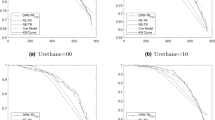Abstract
The empirical survival function of time-to-event data very often appears not to tend to zero. Thus there are long-term survivors, or a “cured fraction” of units which will apparently never experience the event of interest. This feature of the data can be incorporated into lifetime models in various ways, for example, by using mixture distributions to construct a more complex model. Alternatively, first hitting time (FHT) models can be used. One of the most attractive properties of a FHT model for lifetimes based on a latent Wiener process is that long-term survivors appear naturally—corresponding to failure of the process to reach the absorbing boundary—without the need to introduce special components to describe the phenomenon. FHT models have been extended recently in order to incorporate individual random effects into their drift and starting level parameters and also to be applicable in situations with recurrent events on the same unit with possible right censoring of the last stage. These models are extended here to allow censoring to occur at every intermediate stage. Issues of model selection are also considered. Finally, the proposed FHT regression model is fitted to a dataset consisting of the times of repeated applications for treatment made by drug users.
Access this chapter
Tax calculation will be finalised at checkout
Purchases are for personal use only
Similar content being viewed by others
References
Aalen, O.O., Gjessing, H.K.: Understanding the shape of the hazard rate: a process point of view. Stat. Sci. 16, 1–22 (2001)
Ando, T.: Bayesian predictive information criterion for the evaluation of hierarchical Bayesian and empirical Bayes models. Biometrika 94, 443–458 (2007)
Ando, T.: Predictive Bayesian model selection. Am. J. Math. Manag. Sci. 31, 13–38 (2011)
Balka, J., Desmond, A.F., McNicholas, P.D.: Review and implementation of cure models based on first hitting times for Wiener processes. Lifetime Data Anal. 15, 147–176 (2009)
Barr, D.R., Sherrill, E.T.: Mean and variance of truncated normal distributions. Am. Stat. 53, 357–361 (1999)
Berkson, J., Gage, R.P.: Survival curves for cancer patients following treatment. J. Am. Stat. Assoc. 47, 501–515 (1952)
Boag, J.W.: Maximum likelihood estimates of the proportion of patients cured by cancer therapy. J. R. Stat. Soc., Ser. B 11, 15–34 (1949)
Caroni, C., Economou, P.: A hidden competing risk model for censored observations. Braz. J. Probab. Stat. 28, 333–352 (2014)
Cox, D.R., Miller, H.D.: The Theory of Stochastic Processes. Chapman and Hall, New York (1965)
Economou, P., Malefaki, S., Caroni, C.: A threshold regression model with random effects for recurrent events. Meth. Comput. Appl. Prob. (2015)
Griffiths, W.: A Gibbs’ sampler for the parameters of a truncated multivariate normal distribution. Working Paper Series, 856. Department of Economics, The University of Melbourne, Melbourne (2002)
Kaplan, E.L., Meier, P.: Nonparametric estimation from incomplete observations. J. Am. Stat. Assoc. 53, 457–481 (1958)
Lawless, J.F.: Statistical Models and Methods for Lifetime Data, 2nd edn. Wiley, New York (2003)
Lee, M.-L.T., Garshick, E., Whitmore, G.A., Laden, F., Hart, J.: Assessing lung cancer risk to rail workers using a first hitting time regression model. Environmetrics 15, 501–512 (2004)
Lee, M.-L.T., Whitmore, G.A.: First Hitting Time Models for Lifetime Data. In: Balakrishnan, N., Rao, C.R. (eds.) Handbook of Statistics, vol. 23, pp. 537–543. Elsevier, Amsterdam (2004)
Lee, M.-L.T., Whitmore, G.A.: Threshold regression for survival analysis: modeling event times by a stochastic process reaching a boundary. Stat. Sci. 21, 501–513 (2006)
Linhart, H., Zucchini, W.: Model Selection. Wiley, New York (1986)
Maller, R.A., Zhou, X.: Survival Analysis with Long-term Survivors. Wiley, Chichester (1992)
Pennell, M.L., Whitmore, G.A., Lee, M.-L.T.: Bayesian random-effects threshold regression with application to survival data with nonproportional hazards. Biostatistics 11, 111–126 (2010)
Raftery, A.E.: Bayesian model selection in social research (with discussion by Andrew Gelman, Donald B. Rubin and Robert M. Hauser). In: Marsden, P.V. (ed.) Sociological Methodology, pp. 111–196. Blackwell, Oxford (1995)
Spiegelhalter, D.J., Best, N.G., Carlin, B.P., van der Linde, A.: Bayesian measures of model complexity and fit (with discussion). J. R Stat. Soc., Ser. B 64, 583–639 (2002)
Stogiannis, D., Caroni, C.: Issues in fitting inverse Gaussian first hitting time regression models for lifetime data. Commun. Stat. - Simul. Comput. 42, 1948–1960 (2013)
Stogiannis, D., Caroni, C., Anagnostopoulos, C.E., Toumpoulis, I.K.: Comparing first hitting time and proportional hazards regression models. J. Appl. Stat. 38, 1483–1492 (2011)
Yakovlev, A.Y., Tsodikov, A.D., Bass, L.: A stochastic model of hormesis. Math. Biosci. 116, 197–219 (1993)
Whitmore, G.A.: An inverse Gaussian model for labour turnover. J. R Stat. Soc., Ser. A 142, 468–478 (1979)
Author information
Authors and Affiliations
Corresponding author
Editor information
Editors and Affiliations
Rights and permissions
Copyright information
© 2015 Springer International Publishing Switzerland
About this paper
Cite this paper
Malefaki, S., Economou, P., Caroni, C. (2015). Modelling Times Between Events with a Cured Fraction Using a First Hitting Time Regression Model with Individual Random Effects. In: Kitsos, C., Oliveira, T., Rigas, A., Gulati, S. (eds) Theory and Practice of Risk Assessment. Springer Proceedings in Mathematics & Statistics, vol 136. Springer, Cham. https://doi.org/10.1007/978-3-319-18029-8_4
Download citation
DOI: https://doi.org/10.1007/978-3-319-18029-8_4
Published:
Publisher Name: Springer, Cham
Print ISBN: 978-3-319-18028-1
Online ISBN: 978-3-319-18029-8
eBook Packages: Mathematics and StatisticsMathematics and Statistics (R0)




